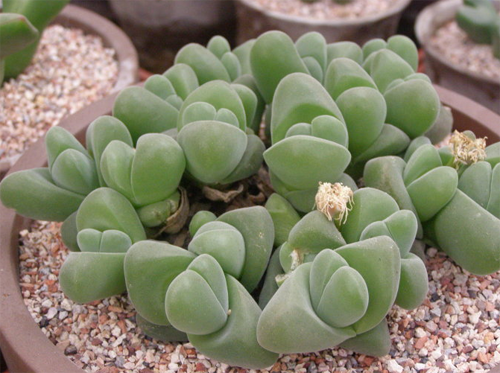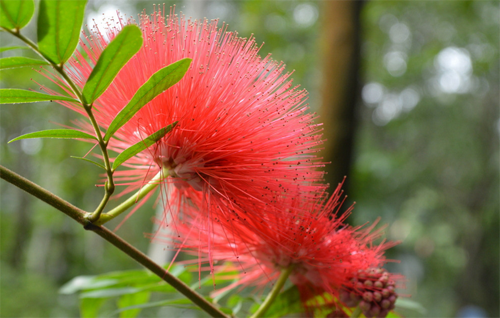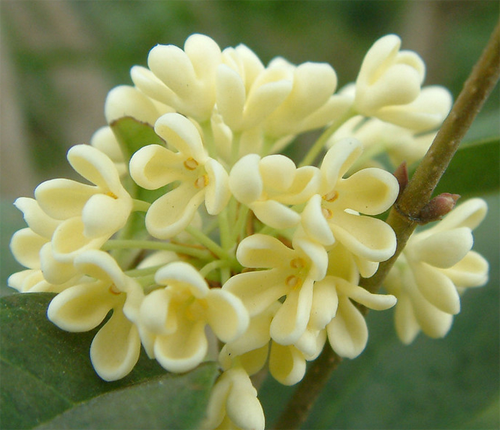The culture method of algal bell jade and its flowering
The algal bell jade is very well-behaved, a bit like a stone flower, and there is a good-sounding name called Yinguangyu, which can blossom. What is the breeding method of algal bell jade? What are the precautions? What other nicknames do you have? What do the flowers look like?

The culture method of algal bell jade and silver jade:
Sowing introduction:
The best temperature for sowing is 15: 25 ℃. When the temperature is below 30 ℃ in autumn, the seeds can be sowed.
In order to prevent the seedlings from being unable to see light after sowing, resulting in overgrowth, you can check the weather forecast for the next 7 days and see that the weather is fine and rainless within a week and then sow.
1. Prepare
The matrix formula of sowing most apricot plants is adopted, that is, peat + small grain deer marsh soil (1mm) is mixed evenly in the ratio of 5: 1, and the pot is ready for use.
2. Disinfection of basin soil
To prevent the soil from carrying weed seeds and harmful germs, it is necessary to disinfect them. The basin filled with soil is soaked in potassium permanganate solution the night before sowing, and the liquid level is not higher than the basin surface.
To prevent killing all beneficial bacteria in the soil and affecting the normal growth of seedlings, the concentration of potassium permanganate solution should not be too high, and it is appropriate for the solution to be dark pink.
The next morning, the basin soil has been soaked by potassium permanganate solution, will be out of the pot to dry, to noon to sow seeds.
3. Sowing seeds
Water the pot soil thoroughly before sowing. The seed of algal bell jade is very small, pour it on the white paper, fold the white paper horizontally, make the paper slot face the basin, and gently tap the paper slot with the camera to make the seed slide evenly to the surface of the soil.
Do not cover the soil after sowing, spray carefully with 1000 times carbendazim water until the bottom of the basin leaks.
The concentration of carbendazim should not be too high, otherwise it is disadvantageous to seed germination. When spraying, the water mist should be fine and the action should be light to prevent the seeds from being sprayed into the soil. After that, cover the spinach with cling film in the sowing pot and put it in a place with plenty of light.
4. After sowing
After sowing, open a small crack in the plastic film every day, ventilate for about 2 hours, spray some water and then cover it. In order to prevent the growth of bacteria caused by high humidity, fungicides are sprayed every 3 days. 1000 times carbendazim and chlorothalonil can be sprayed alternately to prevent bacteria from developing drug resistance.
5. Seedling maintenance
Seven days later, the seedlings sprouted. After budding, the cling film is gradually lifted to give sufficient light to the seedlings to prevent overgrowth. One and a half months later, Xiao Miao began to molt for the first time. At this time, the water should be strictly controlled, and the basin soil can be humidified with a small amount of spray when the soil is too dry.
Seedlings grow tall, easy to stagger, to use small particles of deer marsh soil evenly scattered around the seedlings, not only to straighten the seedlings, but also to ensure that the root neck is not burned by the sun.
Two months later, the "little rabbit" gradually put on weight and became a round little "heart"!
Four months later, Zaolingyu began to molt for the second time, but unlike the first time, the old leaves did not wither, but grew stronger and stronger.
The next 10 days later, he experienced the third molting and the fourth molting in less than a week. Like the second time, the old leaves did not wither but continued to grow vigorously.
The small basin will soon have no room for the crazy growth of them.
After 5 months, they can be transplanted into larger pots to make them grow more vigorously.
Dormant in summer to store nutrients, wait until autumn, it will be able to bloom the most beautiful flowers!
Notes on algal Lingyu:
Algal bell jade likes warm, sunny environment, drought and cold tolerance, fear of stagnant water, suitable for the growth of culture soil containing coarse sand, generally using rotten foliage soil + garden soil + granular soil + coarse sand mixture, as for the ratio can be 4 / 4 / 2 / 2 / 2 / 2.
Algal bell jade growth temperature is 18-24 degrees, the summer high temperature will dormancy, be sure to shade ventilation, no watering or only a small amount of water.
Algal bell jade does not need to be watered frequently, it should be dry and wet in the growing season (no watering in summer, controlled watering in winter), the temperature in winter is more than 10 degrees, move into the room, if the temperature is suitable, you can properly supply water, if the temperature is not good, there is no heating, then cut off the water.
Another name for algal bell jade:
Yinguang jade, hump flower
Algal bell jade blossoms:
Flowers and colors are generally pink, some are white, other colors are less, generally the largest on 2 to 3 centimeters, autumn flowering.
Its flowers are pulled out directly from the hump to produce pink flowers, and only one flower can bloom in a small hump. Only when there is plenty of sunshine can it be completely open. It is the brightest in the afternoon. It closes at night and can open for 7 days in a row.
On rainy days and lack of light, you can't blossom, or it will wither.
This kind of small succulent needs cross-pollination, flower friends who want to pollinate pay attention, and phytoplankton plants are easy to grow in groups and can be propagated separately.
The breeding methods and matters needing attention of algal bell jade are introduced here. Although the flowers are not good-looking, they are also petite and lovable. Hurry up and give yourself some of these little cuties!
How does the petite and round algal bell jade form a group of silver jade?
Yinguang jade, a succulent plant, originated in the Little Kalu Plateau of South Africa, is a perennial herb, very fleshy and clumpy. The base of the opposite leaf unites into a fleshy sheath, the leaf surface is round and convex, similar to ovate, and the fleshy leaf is slightly asymmetric. The leaf surface is thin and the surface is smooth. Ovate leaves with large 1~3cm, basally United. The young plants are solitary, while the old ones are dense. Leaves light green to light grayish green, flowers open from the middle of the two leaves, pink flowers, petals slightly curved, diameter about 3-5cm, generally only one per plant, group flowering will be very spectacular.
'
The silver jade of Zaoling jade opens in the sunny afternoon and closes at night, so the day opens and the night closes for about 7 days. it is difficult to open in case of overcast and rainy days or insufficient light in the cultivation place. plants are cross-pollinated and silver jade plants are easy to grow in groups. If the number of desquamated heads in the coming year will be reduced to 1, the number of desquamated heads will be reduced to 1 in the coming year. At this time, the plant can split up and separate clumps of small groups, so that nutrition will be resupplied. Split heads will also be gradually normal, but the social plants are good-looking and more spectacular.
Zaoling jade belongs to silver jade dormant in summer and grows in other seasons. The peeling period of Yinguang jade will be relatively long, which can spread to the whole growing season. During the peeling period, there is more sun exposure and less water. At the same time, attention should be paid not to sunburn. The peeling of Yinguang jade is that the old skin on the outside slowly dries up, and nutrients are provided to new plants. New plant leaves and old leaves can grow at the same time.
The planting material of Zaoling jade is mainly permeable and breathable, and this variety is not resistant to sunlight. It must be shaded in summer. Yinguang jade can be properly watered during peeling. This variety is usually dry and needs water supply, otherwise the new leaves are easy to sunburn or wither. the semi-woody stem supports the whole leaf and forms a beautiful old pile. Dry watering is watering without soaking the basin. The whole summer sunshade, put in the bright and ventilated scattered light, summer will also give a small amount of water, more will rot.
The water supply can be restored after the autumn temperature comes down, step by step. If the plant is full, it does not need to be hydrated. If you find that the leaves are a little weak, you can replenish the water immediately. It is necessary to avoid frostbite caused by too low temperature in winter. There is no problem when the basin soil is dry at minus 3 degrees. There is a big difference between the north and the south, and flower lovers should breed according to their own environment. Reproduction can be sown or ramets, and meat cones are beautiful only when they are born in groups.
Succulent algal bell jade culture methods, habits, breeding methods, also known as Yinguang jade, the genus Amygdalaceae hump flower (Amygdalaceae), native to the Little Karu Plateau in South Africa, also known as hump flower, named because its top looks like a hump. Because she looked like a "cute rabbit" when she was young, she gave people the impression of being very cute.
Phyllostachys pubescens is characterized by perennial fleshy herbs, the plants are low, the tufted leaves are oval, the top is hump-shaped, and the saddle-shaped engraving divides the plant into two unequal halves. The leaf surface is smooth, light green, the top is triangular, the leaf abaxially arc shape, bend inward into chin shape. Flowers pale pink, pedicellate, ebracteate, 2 Murray 3 cm large. When she was young, Cao Lingyu looked a bit like a bunny, but when she was a little older, she looked a bit like a heart. Growth habits of algal bell jade like warm, sunny environment, drought and cold tolerance, fear of stagnant water, suitable for the growth of culture soil containing coarse sand, choose rotten leaf soil plus garden soil mixed with granular soil or coarse sand. Algal bell jade suitable growth temperature is about 18-24 degrees, high temperature in summer its dormancy, to shade ventilation. The water of plants in this family should be controlled, the watering in the growing season should be dry and wet, and the winter temperature is above 10 degrees. If the heating is good, it can be given an appropriate amount, otherwise it will be broken.
The culture method of Phyllostachys pubescens is to adopt the matrix formula for sowing most of the plants of the family Magnoliaceae, that is, the peat and small granular deer marsh soil (1mm) are mixed evenly in a ratio of 5: 1 and put into a basin for use. In order to prevent weed seeds and harmful bacteria from being carried in the soil, it is necessary to disinfect them: the basin filled with soil is soaked in potassium permanganate solution the night before sowing, and the liquid level is not higher than the basin surface. In order to prevent killing all the beneficial bacteria in the soil and affecting the normal growth of seedlings, the concentration of potassium permanganate solution should not be too high and the solution should be dark pink. The next morning, the basin soil has been soaked by potassium permanganate solution, will be out of the pot to dry, to noon to sow seeds.
Water the pot soil thoroughly before sowing. The seed of algal bell jade is very small, pour it on the white paper, fold the white paper horizontally, make the paper slot face the basin, and gently tap the paper slot with the camera to make the seed slide evenly to the surface of the soil. Do not cover the soil after sowing, spray carefully with 1000 times carbendazim water until the bottom of the basin leaks. The concentration of carbendazim should not be too high, otherwise it is disadvantageous to seed germination. When spraying, the water mist should be fine and the action should be light to prevent the seeds from being sprayed into the soil. After that, cover the spinach with cling film in the sowing pot and put it in a place with plenty of light. After sowing, manage to open a small crack in the plastic film every day after sowing, ventilate for about 2 hours, spray some water and then cover it. In order to prevent the growth of bacteria caused by high humidity, fungicides are sprayed every 3 days. 1000 times carbendazim and chlorothalonil can be sprayed alternately to prevent bacteria from developing drug resistance. Seven days later, the seedlings sprouted. After budding, the cling film is gradually lifted to give sufficient light to the seedlings to prevent overgrowth. One and a half months later, Xiao Miao began to molt for the first time. At this time, the water should be strictly controlled, and the basin soil can be humidified with a small amount of spray when the soil is too dry. Seedlings grow tall, easy to stagger, to use small particles of deer marsh soil evenly scattered around the seedlings, not only to straighten the seedlings, but also to ensure that the root neck is not burned by the sun. After the first molting, the jade looks very much like a "little rabbit"? two months later, the "little rabbit" gradually gained weight and turned into a round little "heart"! four months later, the jade began to molt for the second time, but unlike the first time, the old leaves not only did not wither, but also grew stronger and stronger. The next 10 days later, he experienced the third molting and the fourth molting in less than a week. Like the second time, the old leaves did not wither but continued to grow vigorously. The small basin will soon have no room for the crazy growth of them. Five months later, in order for the algae bell jade to grow healthily, they can be transplanted into a larger basin to make them grow more vigorously. The reproduction of Phyllostachys pubescens mainly depends on sowing and ramets. Algal bell jade is generally carried out in combination with changing pots in spring.
- Prev

The difference between the planting method of albizzia and mimosa
Albizzia flower, many people like to raise it very much, it can not only be used to watch, but also can be used to treat insomnia, how to plant it? When I was a child, how did the seedling look like the mimosa and how to distinguish it? The planting method of albizzia: the red flower is more resistant to cold and drought.
- Next

Can sweet-scented osmanthus culture methods and precautions be raised in the north
Sweet-scented osmanthus blossoms everywhere, is very fragrant, but not pungent, many people like to raise sweet-scented osmanthus, what is the breeding method of sweet-scented osmanthus? What are the precautions? Can you raise it in the north? What should I do if I get cold?
Related
- Fuxing push coffee new agricultural production and marketing class: lack of small-scale processing plants
- Jujube rice field leisure farm deep ploughing Yilan for five years to create a space for organic food and play
- Nongyu Farm-A trial of organic papaya for brave women with advanced technology
- Four points for attention in the prevention and control of diseases and insect pests of edible fungi
- How to add nutrient solution to Edible Fungi
- Is there any good way to control edible fungus mites?
- Open Inoculation Technology of Edible Fungi
- Is there any clever way to use fertilizer for edible fungus in winter?
- What agents are used to kill the pathogens of edible fungi in the mushroom shed?
- Rapid drying of Edible Fungi

